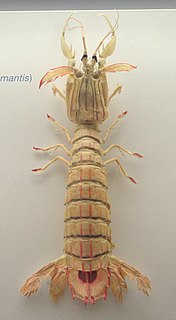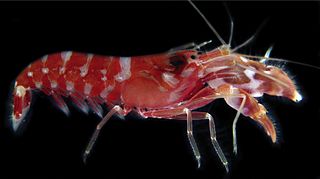
Mysida is an order of small, shrimp-like crustaceans in the malacostracan superorder Peracarida. Their common name opossum shrimps stems from the presence of a brood pouch or "marsupium" in females. The fact that the larvae are reared in this pouch and are not free-swimming characterises the order. The mysid's head bears a pair of stalked eyes and two pairs of antennae. The thorax consists of eight segments each bearing branching limbs, the whole concealed beneath a protective carapace and the abdomen has six segments and usually further small limbs.

Mysidae is the largest family of crustaceans in the order Mysida, with over 1000 species in around 170 genera.

Heterodonta is a taxonomic subclass of saltwater clams, marine bivalve molluscs. This subclass includes the edible clams, the cockles and the Venus clams.

The Trochidae, common name top-snails or top-shells, are a taxonomic family of very small to large sea snails, marine gastropod molluscs in the clade Vetigastropoda.
Upogebia capensis, or Cape mud shrimp, is a mud shrimp of the family Upogebiidae. It is endemic to the Atlantic and Indian Ocean coasts of southern Africa and occurs from Namibia (Luderitz) to Mozambique.

Carcharias is a genus of sand tiger sharks belonging to the family Odontaspididae.

Squilla mantis is a species of mantis shrimp found in shallow coastal areas of the Mediterranean Sea and the Eastern Atlantic Ocean: it is also known as "pacchero" or "canocchia". Its abundance has led to it being the only commercially fished mantis shrimp in the Mediterranean.
The World Register of Marine Species (WoRMS) is a taxonomic database that aims to provide an authoritative and comprehensive list of names of marine organisms.
Ancylomenes adularans is a species of shrimp. It was first named by A. J. Bruce in 2003 in a journal article entitled "Periclimenes species from far North Queens-land".

Alpheoidea is a superfamily of shrimp containing the families Alpheidae, Barbouriidae, Hippolytidae and Ogyrididae.

Shrimp are decapod crustaceans with elongated bodies and a primarily swimming mode of locomotion – most commonly Caridea and Dendrobranchiata. More narrow definitions may be restricted to Caridea, to smaller species of either group or to only the marine species. Under a broader definition, shrimp may be synonymous with prawn, covering stalk-eyed swimming crustaceans with long, narrow muscular tails (abdomens), long whiskers (antennae), and slender legs. Any small crustacean which resembles a shrimp tends to be called one. They swim forward by paddling with swimmerets on the underside of their abdomens, although their escape response is typically repeated flicks with the tail driving them backwards very quickly. Crabs and lobsters have strong walking legs, whereas shrimp have thin, fragile legs which they use primarily for perching.

Atya scabra is a species of freshwater shrimp in the family Atyidae. Atya scabra can reach a length of about 89 millimetres (3.5 in) in males, while females are generally smaller, reaching about 64 mm (2.5 in). It lives on rocky bottoms in rivers connected to the Atlantic Ocean. The species is widespread from Mexico to Brazil, Jamaica, Hispaniola, and Puerto Rico. In Africa, it occurs from Liberia to Angola, the Cape Verde Islands and the islands of the Gulf of Guinea.
Mysidopsis is a genus of mysid shrimps in the family Mysidae. The sensitivity of these shrimps to water quality makes them suitable for bioassays. Mysidopsis bahia and Mysidopsis almyra, which are used frequently to test for pesticides and other toxic substances, are now classified as Americamysis bahia and Americamysis almyra.
Americamysis bahia is a shrimp-like crustacean in the order Mysida, the opossum shrimps. It is native to estuarine waters in Texas and Florida in the United States. It is often referred to in the literature as Mysidopsis bahia and is widely cultured and used in the laboratory for toxicology testing.
Americamysis almyra is a shrimp-like crustacean in the order Mysida, the opossum shrimps. It is native to estuarine waters in the western Atlantic Ocean and Gulf of Mexico. It is often referred to in the literature as Mysidopsis almyra.

Gastrosaccus spinifer is a shrimp-like crustacean in the order Mysida, the opossum shrimps, native to the eastern Atlantic Ocean and the coasts of Northern and Western Europe.
Palaemon ritteri is a species of shrimp of the family Palaemonidae.
Urocaridella cyrtorhyncha is a species of shrimp in the family Palaemonidae. The species is similar to U. urocaridella, U. antonbruunii, and U. pulchella. The species is found in the Indian and Pacific Oceans, including the Red Sea.
Acanthephyra purpurea is a species of deep sea shrimp described in 1881.









